November 22, 2013
Air Date: November 22, 2013
FULL SHOW
SEGMENTS

Warsaw Wrapup
View the page for this story
Representatives from 195 nations and civil society organizations recently met in Warsaw, Poland to continue work on the UN's treaty addressing global climate change. Jennifer Morgan of the World Resources Institute tells host Steve Curwood that tensions were high over the reluctance of developed nations to accept liability for extreme weather and rising oceans. At one point the slow progress at COP19 prompted a mass walkout of environmental groups and NGOs, but 27 hours after the negotiations were scheduled to end a deal was struck to keep the process on target for approval of a final agreement in 2015. (08:40)

Mapping the World’s Forests
View the page for this story
Any new international climate agreement is expected to include REDD—the reduction of emissions from forest degradation and destruction. Tropical forest losses accounts for about a fifth of all global carbon dioxide emissions, more than all transportation. A new endeavor using Google Earth has created the first high-resolution map of global forest cover change. Matt Hansen from the University of Maryland tells host Steve Curwood that the maps revealed some surprising discoveries. (06:25)

Power Shift - Building A Smarter Light Bulb
/ Steve CurwoodView the page for this story
A new company in downtown Boston has come up with a smart lighting system that can boost productivity and save users as much as 90% on their energy costs. Host Steve Curwood takes a tour of Digital Lumens to see how they’ve done it. (08:35)

Patents to Rescue the Climate
View the page for this story
Across the US average citizens are coming up with innovative, sometimes wacky, inventions to combat climate change. James West, senior producer for Climate Desk, tells host Steve Curwood about a couple of unusual patents he found, including a carbon absorbing golf ball. (06:40)

Antarctic Volcano
View the page for this story
Many scientists are concerned about the impact global warming is having on the Antarctica, and Doug Wiens from Washington University in St. Louis tells Steve Curwood that he’s discovered a new kind of threat lurking beneath the vulnerable West Antarctic ice sheet—an active volcano. (06:45)

BEYOND THE HEADLINES
View the page for this story
In our weekly look beyond the headlines, Peter Dykstra of the Daily Climate and Environmental Health News discusses a new green army to tackle erosion in Louisiana, an undersea toxic dump that's mysteriously getting cleaner and the anniversary of the end of supersonic passenger transport with host Steve Curwood. (05:00)

Vegans Say It's Even Better Than Turkey
/ Didi EmmonsView the page for this story
Vegan eaters may consider Thanksgiving a gastronomic challenge, but chef Didi Emmons meets this challenge with relish - or rather, seitan. The author of “Vegetarian Planet,” shares with Living on Earth her tried and true vegan turkey substitute. (04:00)
Show Credits and Funders
Show Transcript
Host: Steve Curwood
Guests: Jennifer Morgan, Matt Hansen, James West, Douglas Wiens, Didi Emmons, Peter Dykstra
Reporters: Steve Curwood
[THEME]
CURWOOD: From Public Radio International, this is Living on Earth.
[THEME]
CURWOOD: I’m Steve Curwood. Oxfam, Greenpeace and the World Wildlife Fund lead a walk- out at the UN’s deadlocked climate negotiations in Warsaw.
NAIDOO: This action is a clear statement that this particular COP is a complete betrayal of the sense of urgency that is needed. Our message to our leaders is - understand that nature does not negotiate.You cannot change the science and we have to change the political will.
CURWOOD: But many world leaders don't seem to be listening. Also, cutting energy use and emissions - one smart light system at a time.
ANDERSON: The utility provider, once they installed our fixtures, didn’t quite believe their meter. They actually sent someone out to go check the meter, make sure it was actually functioning because of the amount of energy we were saving. They started monitoring it to make sure they weren’t trying to pull a fast one over them.
CURWOOD: We'll have those stories and more this week on Living on Earth. Stick around.
[NEWSBREAK MUSIC: Boards Of Canada “Zoetrope” from “In A Beautiful Place Out In The Country” (Warp Records 2000)]
ANNOUNCER: Funding for Living on Earth comes from Stonyfield Farm, makers of organic yogurt, smoothies and more.
Warsaw Wrapup
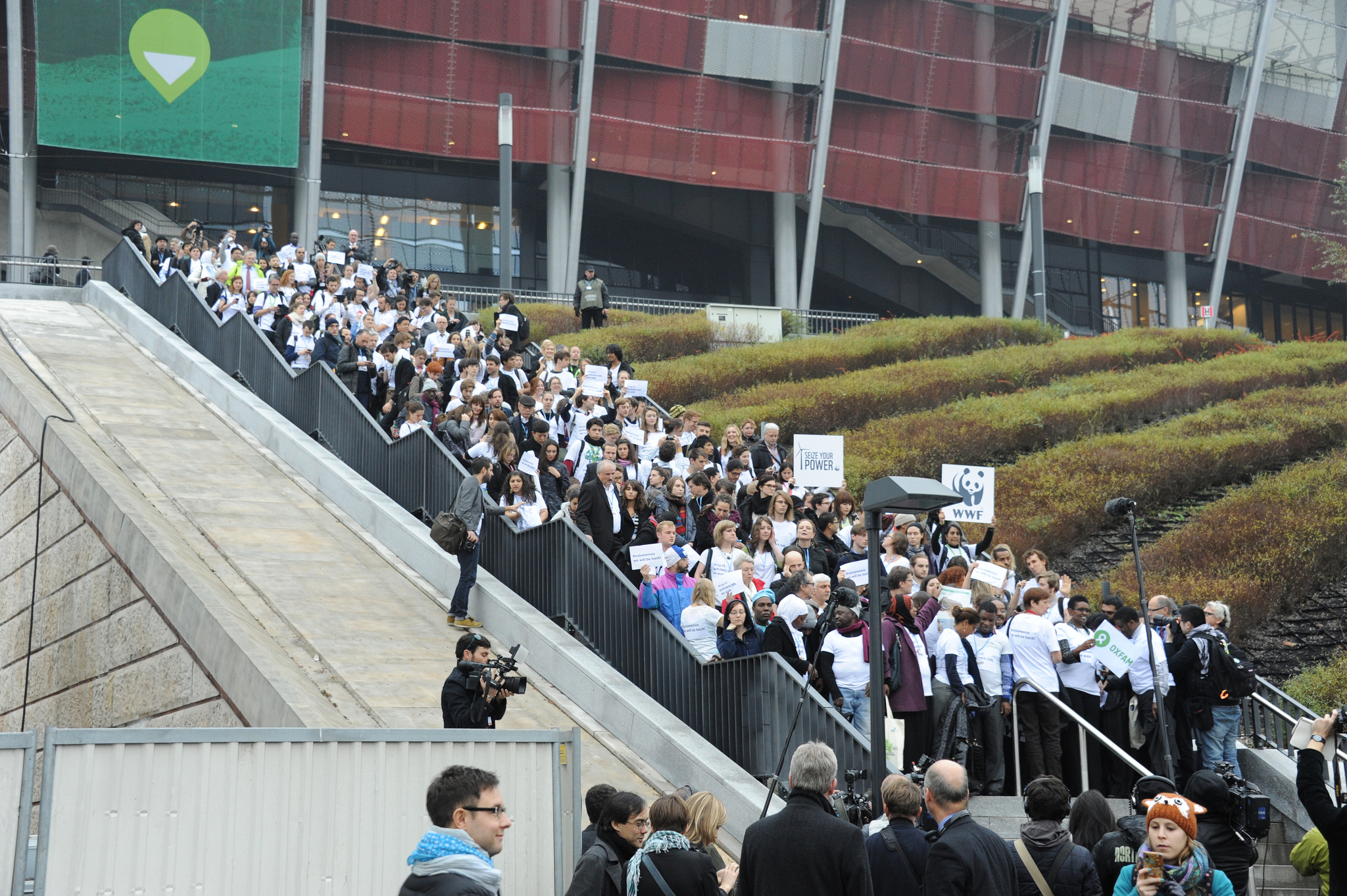
Environmental groups and NGOs stage mass exodus of the COP19 climate talks in protest of slow progress. (UNFCCC)
CURWOOD: From the Jennifer and Ted Stanley Studios in Boston, this is Living on Earth. I’m Steve Curwood. Diplomats and advocates spent the last two weeks in Warsaw, Poland, at the UN's annual climate meeting, or COP. They made virtually no progress, despite a hunger strike in sympathy with Filipino victims of Typhoon Haiyan and the deadlock ultimately sparked an unprecedented walk-out by NGOs. Kumi Naidoo leads Greenpeace International.
NAIDOO: This action is a clear statement that this particular COP is a complete betrayal to the sense of urgency that is needed. Our political leaders have the temerity to tolerate the fact that we are called hooligans when in fact the real hooligans are the CEOs and the real bosses of oil, coal and gas companies that have completely captured our governments, and they have completely captured this negotiating process. It is an insult to us that this COP is largely sponsored by the coal industry. We are not disrespecting the United Nations or the United Nations Framework Convention on Climate Change. It is the individual positions that powerful governments bring here that is holding up the process. That is why our commitment here is not simply saying, “We’re walking out.” We are saying, “We’re walking out, and we’re committing ourselves to mobilizing the largest number of people in every single country in the world, to say to every parent, ‘Your child and your grandchildren’s future is at stake. You need to stand up now and take action so that when we get to the next COP in Lima, Peru, next year, we have a fighting chance to lay the foundations for a fair, ambitious and legally binding treaty when we get to Paris,”- something by the way that we were supposed to have achieved in Copenhagen. So our message to our political leaders: Understand that nature does not negotiate. You cannot change the science, and we have to change political will.
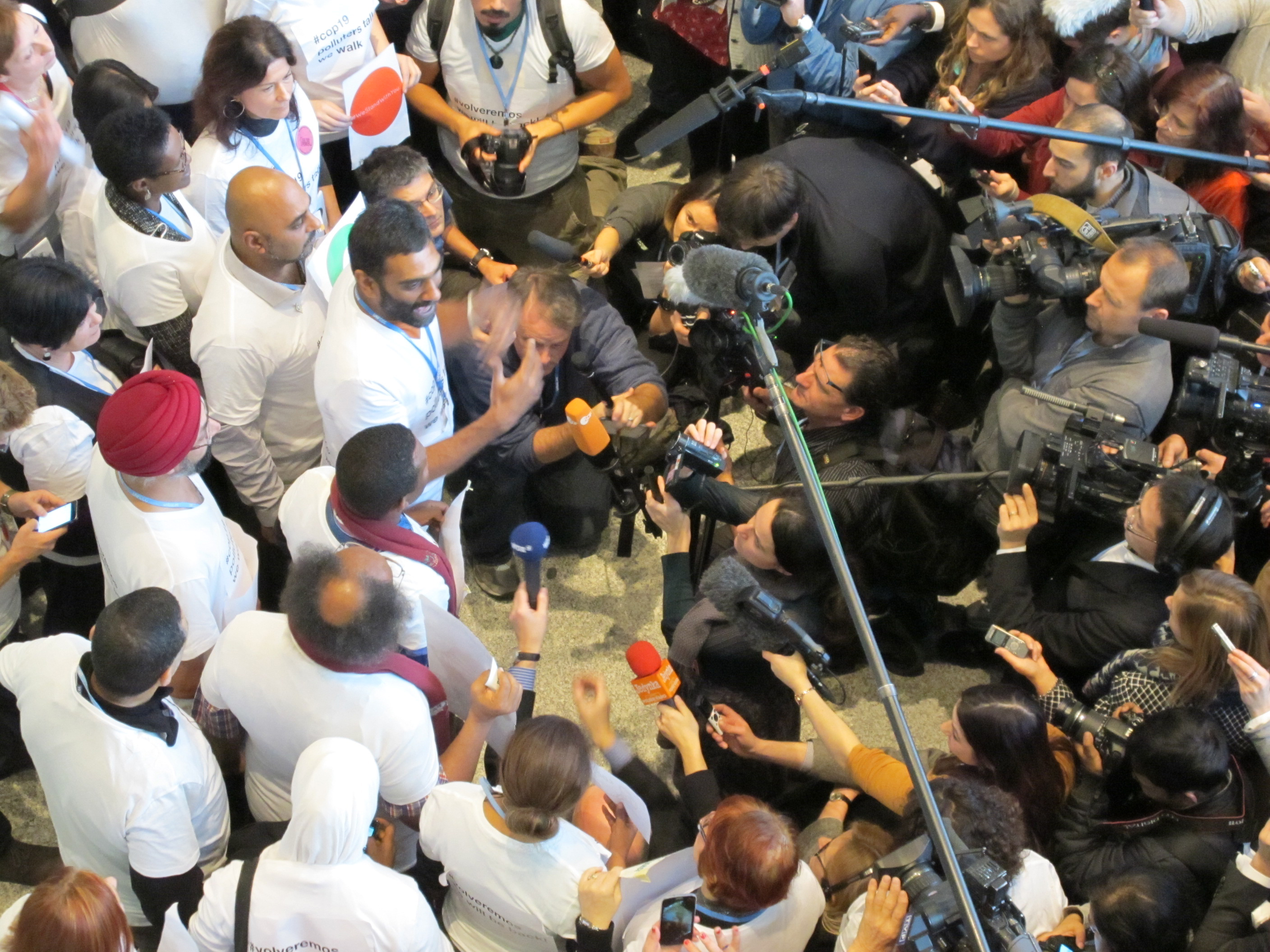
Kumi Naidoo, executive director of Greenpeace International speaks to the media about the walkout. (Photo: Brendan DeMelle, DeSmogBlog)
CURWOOD: Joining us now from Warsaw to put this all in context is a veteran of all 19 of the UN's climate COPs, Jennifer Morgan, director of the climate and energy program at the World Resources Institute.
MORGAN: Well, I think you’re seeing a deep, deep frustration with the response of governments and corporations to the crisis that’s occurring on climate change right now, and the feeling like they needed to shout out to the world that it’s just not enough, what’s happening inside these halls or back in capitals to address the problem.
CURWOOD: What are these groups like Oxfam and World Wildlife Fund saying they’re going to do to get the political will needed to have their governments push for success at meetings like this?
MORGAN: Well, I think what I’ve heard those groups say is that they’re going to go back to capitals, they’re going to join forces with other movements, other groups, in order to put pressure both on the fossil fuel industry which they hold rightfully responsible for emissions, but also directly on governments. Japan and Australia have been the big stories here in the last two weeks, so it’s really heading back home into the politics to try and change them.

Jennifer Morgan is director of the Climate and Energy Program at World Resources Institute. (World Resources Institute)
CURWOOD: What did Japan and Australia do at these talks?
MORGAN: Unfortunately, separately, Australia’s new government has announced that they are not going to increase their pledge from a five percent target - what they have right now - up to a 25 percent target which the previous government was considering. Japan has announced that it’s going to weaken its target to tackle climate change quite significantly, in a way that would allow its emissions to grow, and that, both Australia and Japan, has created tremendous anger in civil society and also of course in a number of countries around the world, China included, African countries included, about this walkback, those two countries.

L-R, Christiana Figueres, UNFCCC executive secretary; Ban Ki-moon, Secretary-General of the United Nations; and UN Spokesperson (Photo: UNFCCC)
CURWOOD: How angry are these nations? What talk is there about taking more stringent action?
MORGAN: Well, I think they’re very angry but at the same time, I would say the most constructive delegations here in the negotiations about how to move forward and getting a new agreement have been the African nations. For example, South Africa has brought forward a very interesting proposal around the issue of equity which gets to the heart of how do you know whether an agreement is fair or not? How much does each country have to do, which is at the very core of these negotiations. Africa’s come in with a proposal that brings in science, tries to move the debate forward in really tackling, OK, who’s responsible for the past, but also, who’s responsible, and likely to be responsible, for the future?
CURWOOD: Now, what happened with the developing nations at the loss and damage talks?

The official logo of the United Nations Convention on Climate Change. (UNFCCC)
MORGAN: On the issue of loss and damage, it’s really about what happens when a country can’t prepare for an extreme weather event or something like sea level rise that’s caused by climate change, and there’s permanent damage. People lose their homes, they lose their whole livelihoods. How do those people get taken care of? And developing countries feel that because developed countries are most responsible for the problem, that they should take care of them, of those people who have suffered such damage. Developed countries, on the other hand, while they sympathize, are quite nervous.
CURWOOD: What exactly are the developed countries so nervous about?
MORGAN: Well, I think when the words such as, can you be held liable for these types of events; they’re worried about having to pay large sums to support the revitalization or rebuilding of cities around the world, and being held responsible for that.
CURWOOD: And what about places that might disappear under rising seas?
MORGAN: Well, certainly places, small islands, that could disappear are very much at the forefront of this debate with their worries, and they have a case. What happens when their island disappears? Where do they go? Who takes care of them? It’s a huge moral issue of our time, I think.
CURWOOD: How was Poland as the leader of these talks since it was the host country, it chaired them.
MORGAN: Poland was an incredibly controversial president at this COP due to their role within the European Union of holding back action. It’s very well known that they’ve blocked Europe from moving forward, for example, to a higher target. They hosted a coal conference here in the middle of a climate meeting when it’s quite clear that coal is one of the biggest polluters and causes of climate change. So it hasn’t been, let’s say, the most progressive president that has hosted a COP.
CURWOOD: What should American citizens know about how the US government conducted itself at these talks?
MORGAN: I think they should know that the US government is starting to get more credibility internationally through the leadership of President Obama and his administration to actually take domestic action to tackle the problem. But they should know that there is a great expectation that the US works with others to go much further, to work together with other major economies, to drive emissions down at a much greater scale than there is right now.
CURWOOD: We’re talking to you before the final gavel comes down on these talks, but at the end of the day, what do you think is likely to be the ultimate outcome here?
MORGAN: I think there’s two things that I hope come out of this meeting. The first is really just a broader sense of what’s at stake to the public and leaders around the world, a signal to high carbon industries that they just can’t keep going the way that they’ve been going. We’re in a crisis. I hope that somehow that message comes through to the broader public. The second is the very nuts and bolts decisions that need to come out of a meeting like this. I hope there’s a clear pathway to getting an ambitious and fair agreement in 2015, and that there’s new initiatives that come forward that say we’re going to act now.
CURWOOD: Jennifer Morgan is Director of the Energy and Climate Program at the World Resources Institute. Jennifer, thanks so much for taking this time today.
MORGAN: Thank you very much.
Related link:
United Nations Framework Convention on Climate Change
Mapping the World’s Forests
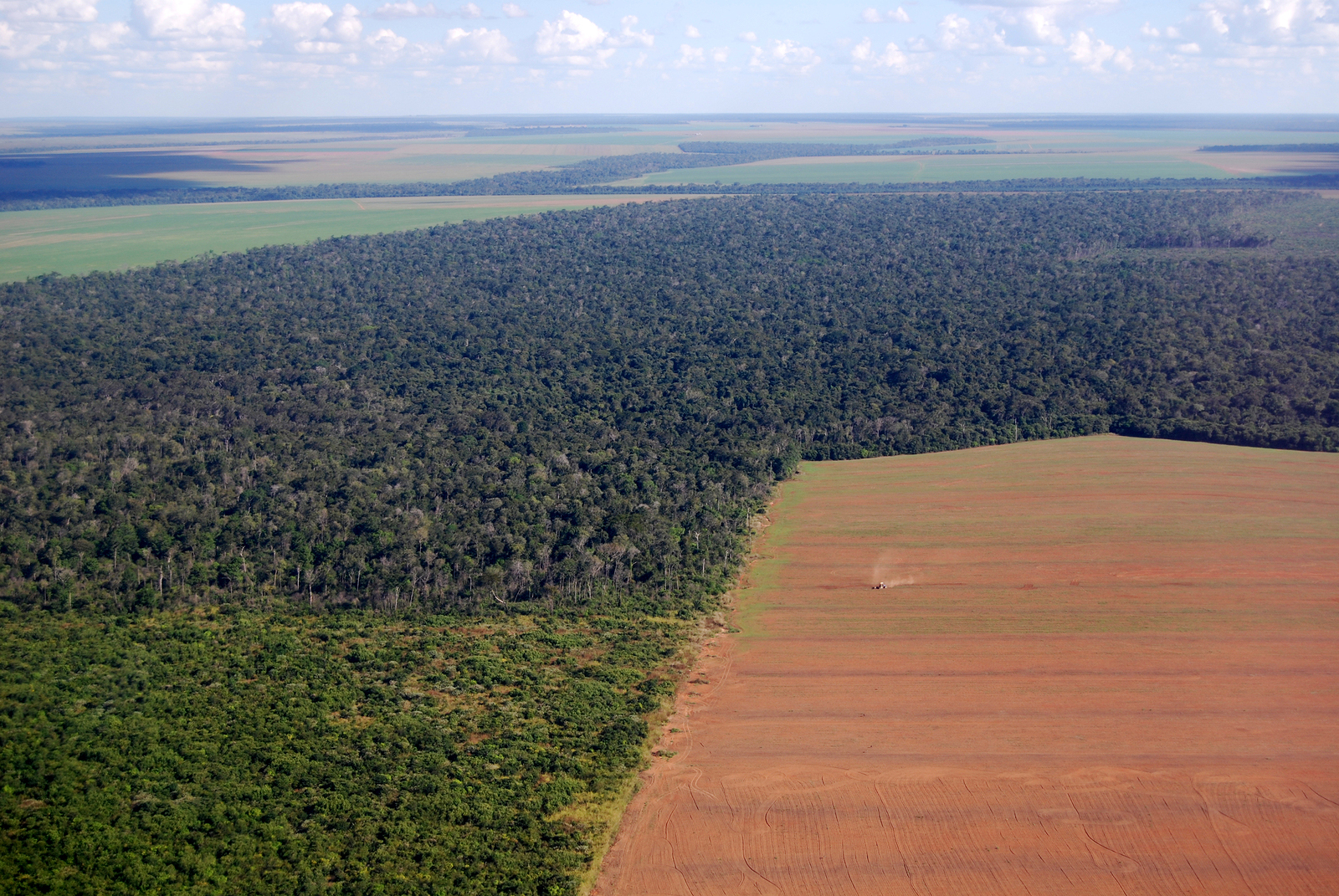
Deforestation clears land for soy production in Brazil (photo: bigstockphoto.com)
CURWOOD: If any new international climate agreement is ever worked out, it's expected to include REDD, a deal to reduce emissions from forest degradation and destruction.At the moment, loss of tropical forests accounts for about a fifth of all global carbon dioxide emissions, more than all transportation. And to forge a deal, there will need to be measurement and verification of what’s happening on the ground. Now negotiators and conservationists have a new tool: a collaboration that includes GoogleEarth, NASA, USGS, the University of Maryland and the Woods Hole Research Center that has produced the first high resolution map of global deforestation. Matt Hansen, of the University of Maryland was the lead author of a paper in Science that presented the project. Welcome to Living on Earth.
HANSEN: Thank you very much for having me.

Forest cover change is represented in red. (Hansen, Potapov, Moore, Hancher et al., 2013)
CURWOOD: So this is an interactive map of forest cover around the world. How exactly does this work?
HANSEN: Well, the interactive map is fantastic in that it allows people to see the results of our study. The map is this great global overview where you can look at the patterns and density and tree cover, and on top of that look at the losses and gains over the 12-year-period that we produced this map, and at the same time you can take the roller button on your mouse and zoom down to a 30 meter square on the Earth and see what happened to that particular patch of ground. So we promote it as a globally consistent locally relevant product, and we can go down and look at individual clearings.

Deforestation in Indonesia is represented in orange. Hansen, Potapov, Moore, Hancher et al., 2013)
CURWOOD: Now where did you get the data to make these maps?
HANSEN: These maps are based on a Landsat 7 satellite. Landsat is a long running series of satellites jointly operated by NASA and USGS. Starting in 1999, this particular Landsat was systematically acquiring images everywhere. Once you have it updated everywhere, you can start thinking about mapping everywhere. And then the other thing that had to come together was high-performance computing. Once they open up the archive, we’re like, wow. OK. Now how do we query and process hundreds and thousands of these images, and when we did it in the GoogleEarth engine highly parallelized environment, what would have taken 15 years on one CPU took a few days.
CURWOOD: So what kind of data did we have before this was available? I’m thinking of places like tropical forests in Africa, Congo, where government isn’t able to collect this type of information.
HANSEN: Right. Well, that’s where it’s most valuable. If you have the view from space on a place where there is no forest inventory being collected, these data are really valuable so that’s what we’ve always promoted. We’ve been working on the Congo Basin for 15 years, and we’ve produced this type of data there, in Indonesia, and the like. But the only country that produces annual data like this is Brazil, and they release the data. Other countries use remote sensing, but they don’t openly share the data. Thinking more of Indonesia; Indonesia has the capability, they don’t share their data so well; it’s very hard to tease out what’s really happening in Indonesia.
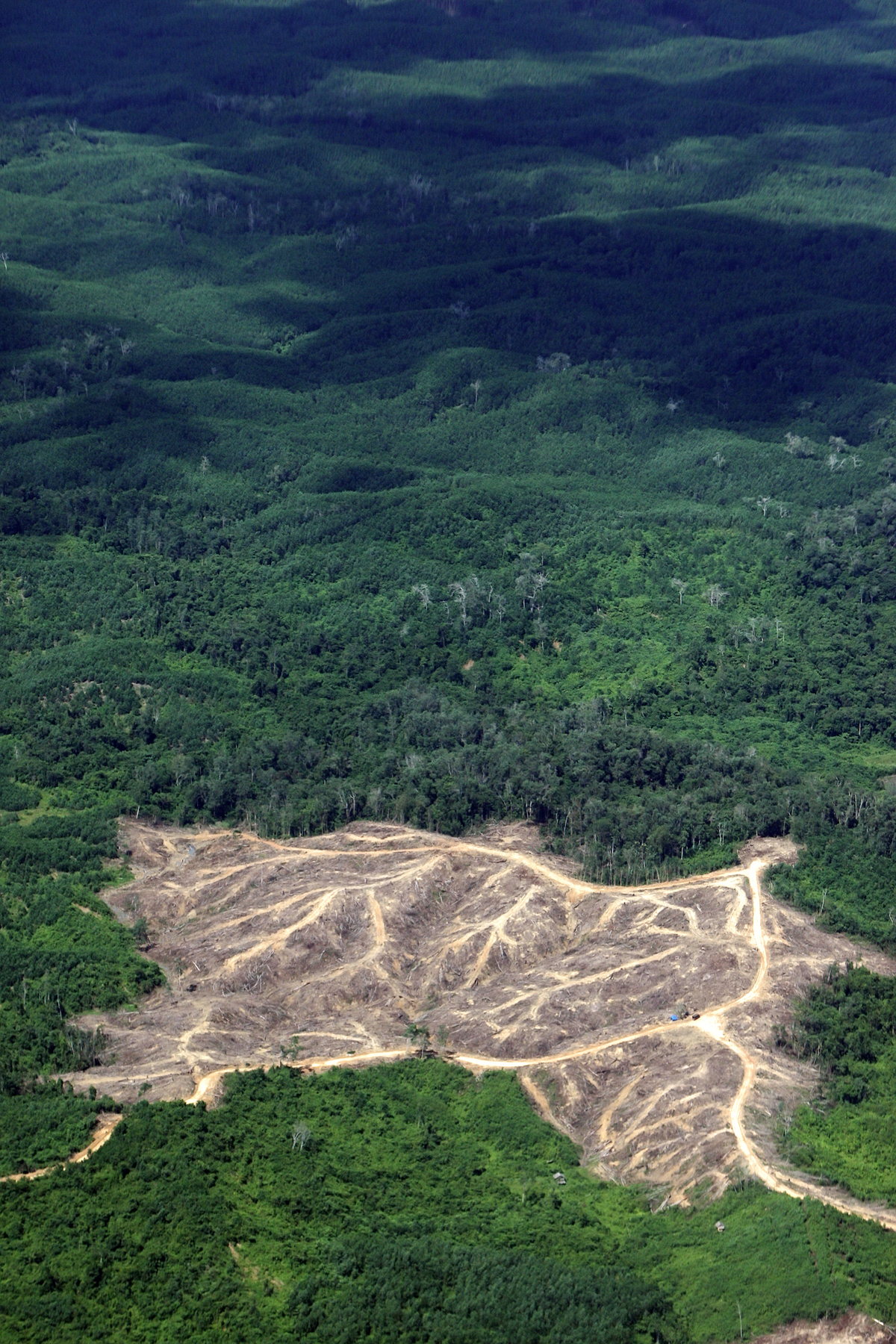
Deforestation in Borneo (photo: Bigstockphoto.com)
CURWOOD: I looked at your map and zoomed in on Indonesia...wow. Look how much deforestation has increased there in the last 12 years.
HANSEN: Yes. Indonesia was, in our study, the most annual increase, about 1,000 square kilometers additional per year of the study period, that is the appropriation of natural forest for higher order of use like palm oil or pulp.
CURWOOD: Deforestation on the rise in Indonesia. Where else are you seeing it on the rise?
HANSEN: In Malaysia, they are really converting their natural forests, and when you look at the middle of Borneo, you see this line where the logging roads in Malaysia go right up to the borders, so the intensity of forest logging and conversion in Malaysia is much higher than in Indonesia. If you look at the Chaco from Bolivia to Paraguay and Argentina there’s all loss, no gain. It is a deforestation dynamic converting almost an entire eco-region in a period of 20-30 years to pasture lands and soybean production, even small isolated events. We had one changed pattern in China that we couldn’t figure out. It looked like noise. We thought there was a problem with the data, but it was actually forests sliding off of a mountain range west of Chengdu. In 2008 they had the Sichuan earthquake and these forests literally slid off the mountain tops and it’s a very strange pattern, but it’s a true pattern. So there’s all kinds of things going on in these data, but a lot of it is tropical. The rates have increased in tropics is the most arresting, I would say.
CURWOOD: Looking at west Africa, a lot of hotspots there too.
HANSEN: West Africa, the main hotspot is Cote d’Ivoire. Cote d’Ivoire in the last 12 years has gone through two civil wars. In this period of instability, there’s been a large conversion of a lot of protected areas, national parks and forest reserves, so these big patches, these big polygons of forest, and it tells you how fragile national and natural heritage can be. You might set aside 20 percent of your lands for protected areas, but if you go through a bad period, you could lose it. On the positive side, you can see a big forest block. It’s the iconic forest of west Africa, that’s Taï National Park, that’s a World Heritage Site, and that’s intact. It’s in Cote d’Ivoire. It survived all this instability. It’s where they filmed the Disney movie Chimpanzee and it looks great.
CURWOOD: Of course, the vast majority of trees are in the tropics, but I noticed when I went to the southeastern United States, there was a lot of deforestation going on there. What’s happening in this country?
HANSEN: The southeast United States, it’s a tree farm, basically. The forestry land use is very intensive, and trees are grown and harvested for pulp and timber purposes. It’s not deforestation, but it does have implications on habitat and other ecosystem services, whether it’s carbon or water cycle. When you look at the landscape, you try to find an intact habitat, and you’re going to look long and hard because it is a really really intensively disturbed and used landscape.
CURWOOD: Why is it important to have a map like this?
HANSEN: We can use it regionally to model hydrology effects on biodiversity, people use our maps in ways that we can’t imagine. Someone used a map of ours - forest cover in Malawi relating dietary diversity to health outcomes and people that have access to tree cover had more diverse diets and better standards in terms of health, so we are really excited that when we get this data out, people use it at a global scale, they use it at a local scale, they’re use it for predictable science applications, and some we haven’t even anticipated.
CURWOOD: Matt Hansen is a Professor of Geographical Science at the University of Maryland. Thank you so much, Sir.
HANSEN: Thank you.
Forest loss in Indonesia
Deforestation in Paraguay
Related link:
Explore The Global Forest Change Map
[MUSIC: Bomba Estereo “Bosque” from Elegancia Tropical (Soundway Records 2012)]
CURWOOD: Coming up...getting smart with lights to save money, lots of energy and learn more about ourselves. Keep listening to Living on Earth.
[CUTAWAY MUSIC: Coleman Hawkins: “Groovin” from Soul (Prestige Records 2006 Reissue)
Happy Birthday Hawk (11/21/1904 – 05/19/1969)]
Power Shift - Building A Smarter Light Bulb
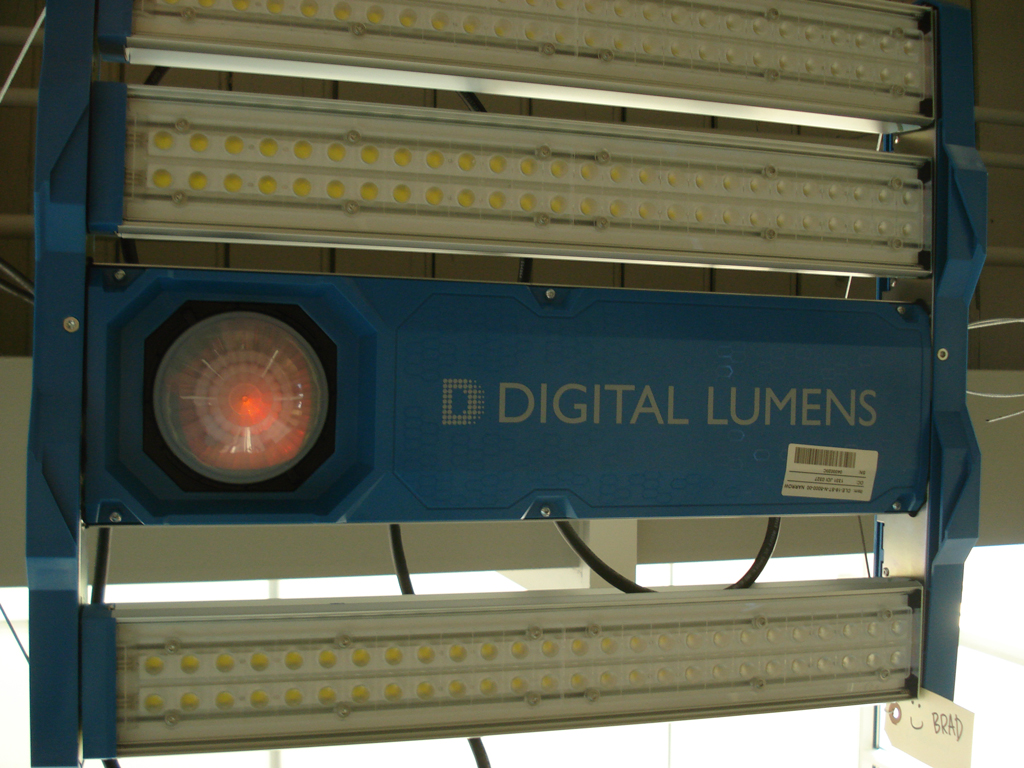
The Digital Lumens lighting system. (Kathryn Rodway)
CURWOOD: It’s Living on Earth, I’m Steve Curwood. And now, another in our series Power Shift, about the transition to low carbon energy in the Bay State.
[POWER SHIFT THEME MUSIC]
CURWOOD: The other day we headed down into what Boston calls the innovation district to visit a company called Digital Lumens. We went to see a better light bulb. But the first thing we see as we meet CEO Tom Pincince is a rack full of items invented more than a century ago, bicycles.
PINCINCE: There are a lot of bicyclists; probably about half of the company bikes here everyday. So we have a full 20 to 30 bike parking lot on the wall.
CURWOOD: So your place here kind of looks like a warehouse. Maybe once upon a time it was? Or something like that?
PINCINCE: We’re in the old wharf district of Boston. This is where all the goods came and went. The innovation district is the old seaport. We’re in an open space, we have about a 15 foot ceiling here. You can see the floor and the exposed beams of the company above us.
CURWOOD: Just as the bicycle is a cheap and appropriate technology to save time in this era of congested streets, Digital Lumens had an idea to marry cheap appropriate technology to the efficient LED light bulb and save up to 90 percent of energy and costs.
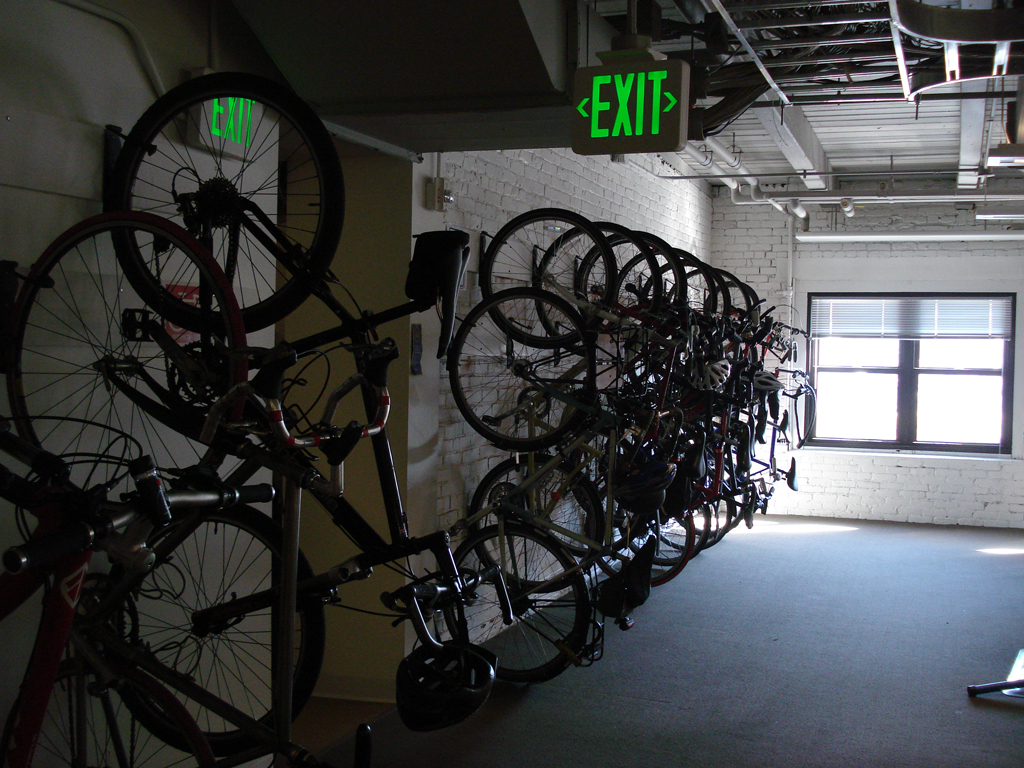
Bike parking in the Digital Lumens office. (Kathryn Rodway)
PINCINCE: The idea was to make every light in the world intelligent, and put little computers into every single light.
CURWOOD: These digital devices figure out just when and where lighting is needed.
PINCINCE: These little computers talk to each other and they talk to a main computer that will help them work in context with what is going on in the building and what’s going on in the environment.
CURWOOD: Tom points to an overhead array of LED lights that have built in computer chips, light sensors and networking devices.
PINCINCE: And this is one of the areas where we try out our light. You’ll see above you; these are our new generation lights we just released days ago. Then over there are the ones that we’ve been shipping for three or four years.
CURWOOD: At first glance the lights don’t look different from other LED fixtures. I asked engineer Steve Condo just how big is the computer on these lights.

Engineer Steve Condo holds the Digital Lumens computer he helped design. (Kathryn Rodway)
CONDO: It’s pretty small. It will definitely fit in the palm of your hand. Basically this size here - it’s actually the size of a post-it note, and this houses a considerable amount of intelligence so it can detect people so it’s an occupancy detector. You can see how much light is on the floor at the time, not just how much the light is delivering but how much light is coming in from other sources whether it’s skylights, windows, high reflective surfaces. So you’re looking at the total picture.
CURWOOD: So if it’s bright outside, the lights dim and if it clouds up the lights compensate. The computers integrate other factors such foot traffic. So, for example, if you are walking in a huge warehouse, instead of lighting up the whole area, the system illuminates the place you are in. And because it’s smart, it also lights up the section you are headed for, so you don’t have to wait in the dark until a sensor notices you’re there. Brian Chemel saw the potential of marrying efficient LED lights to tiny computers and founded the company in 2008 with a team of engineers and one core concept.
CHEMEL: We realized that there are a lot of trends working in our favor to making every light intelligent. The costs of adding a microcontroller to a product are plummeting; the fact that we all have smart phones in our pockets means that th little chunks of hardware that those systems use are available for a bunch of other applications. At the same time, it’s never been cheaper to make software run out in the cloud. We can leverage a bunch of different trends and we’re sort of at the right time to make this work.
CURWOOD: And why do this?
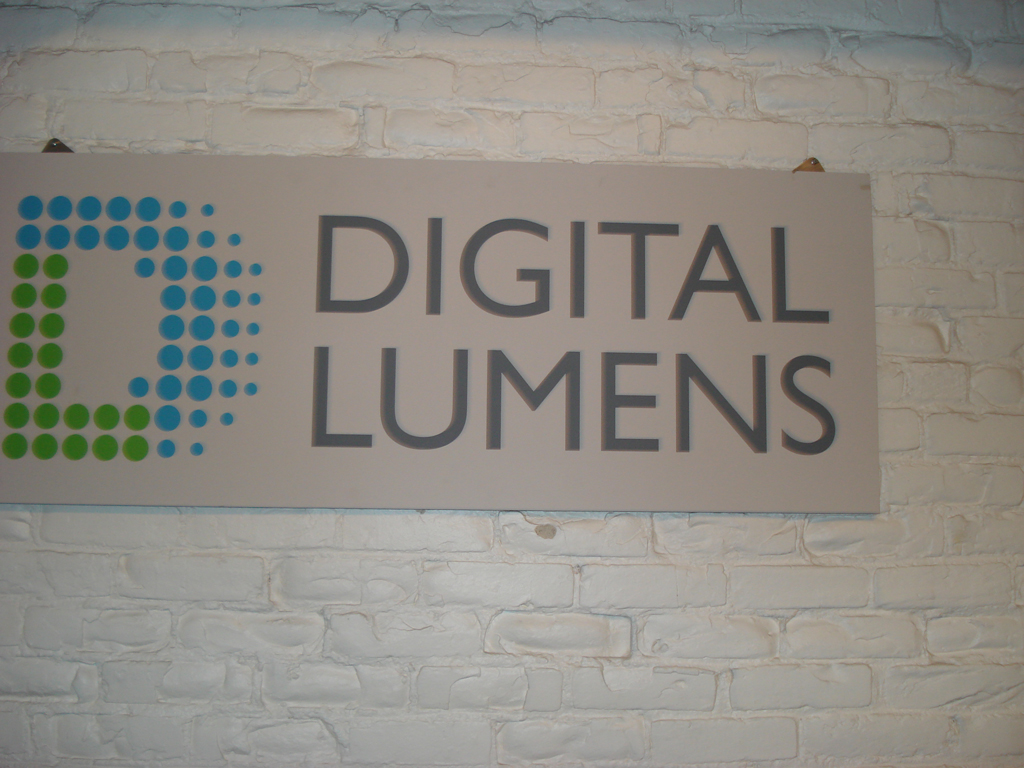
(Kathryn Rodway)
CHEMEL: We are making every light intelligent for two reasons. One is that is drives tremendous energy efficiency. We say radical energy efficiency, much more than just switching to LED light sources. When you make the lights smart you get a lot more energy savings. The second is were building a platform for distributed building intelligence. Lights are the perfect Trojan horse for instrumenting the built environment. Parking garages that can track people moving through them for safety reasons, for billing reasons. Retail stores that can anonymously monitor traffic flow inside them to tell advertisers how long people are pausing in front of end caps to see product information. It’s really a lot of themes that get pulled together by lighting because it is so pervasive.
CURWOOD: Associated Wholesale Grocers of New England based in Pembroke, New Hampshire was one of the first customers of Digital Lumens. Associated serves over 600 independent food retailers with one of America’s largest purchasing and distribution centers. We called up Bruce Courtois, the facilities manager to see how the lighting system worked for him.
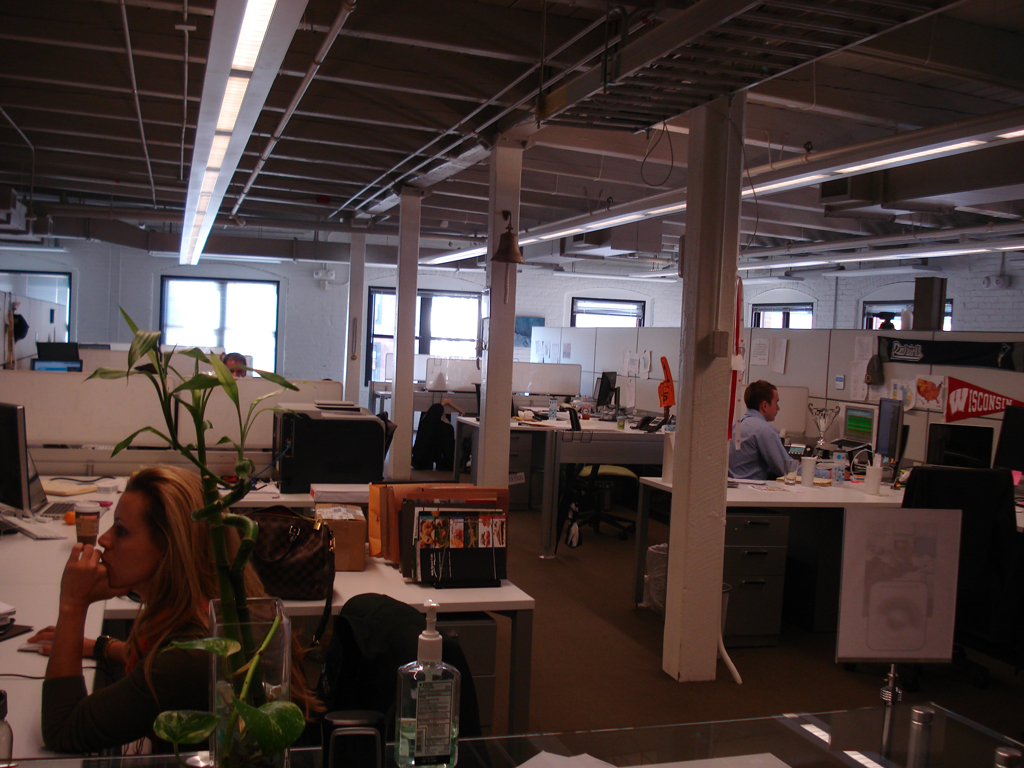
The Digital Lumens office. (Kathryn Rodway)
COURTOIS: We first did a section in our freezer - oh about a year ago and that’s when we were first introduced to the product and after that it was a no brainer. The savings have been tremendous, tremendous. We saved about 1.6 million kilowatt hours in just electricity alone. It comes down to about $200,000 dollars a year in our electric bill. With that and a rebate that we got from New Hampshire the payback on this was a little over a year. There are different LED lights on the market but the Digital Lumens product is a little bit advanced compared to other LED lighting.
CURWOOD: And Courtois outlined some other benefits.
COURTOIS: It tells you where there’s motion all of the time. All of a sudden you’re saying, well why are people always going to this part of the building at the beginning of a shift for a certain thing? Found out that it's a common product that everyone kind of orders. We moved that up to the front of the warehouse so there’s less travel time. Less travel time equates to more dollars and the light levels are so much brighter. Work production boosted because people could see better. It gives the person or company that installs this the creativity, I guess, of fine-tuning the lighting to how their needs are.
CURWOOD: Still with new technology involving computers, there can be glitches. Back at the Digital Lumens headquarters in Boston, product manger Tom Anderson said there is a steep learning curve, and customers can have problems.
ANDERSON: Usually it’s maintenance of our system. Our system has a lot of IT components, and so maintaining the communication between all of our lights and system can present some issues. So we work with them to make sure that we can resolve those issues remotely by connecting to their system and troubleshooting it from here.
CURWOOD: All in all, the company has had success after success. Again, engineer Steve Condo.
CONDO: I think the best one that I like was when we were releasing the 2nd generation product, we did a demo installation in a warehouse in Chicago. We put them up there and everything went great. The utility provider, once they’d installed our fixtures didn’t quite believe their meter. They actually sent someone out to go make sure that the meter was actually functioning because of the amount of energy we were saving. They started monitoring it to make sure they weren’t trying to pull a fast one over them. That’s like the best testimony. I think it’s my favorite because its entirely doable and it happens. People don’t believe you but it happens.
CURWOOD: And because it happens Digital Lumens has taken its better light bulb all the way to the bank. They started with five employees and now they are up to 100. And CEO Tom Pincince and his team have even bigger ideas.
PINCINCE: As I said earlier, we’re trying to make every single light intelligent. We’re going to start with industrial lights, go to office lights but pretty soon you’ll see intelligent lights in your home. We talked about what will that light know. Well, it may know a lot about you. So for instance, if you are one of those people who’s the quantified self, let’s say you have a heart rate monitor, and you jog, and you take your weight measurement every day. It may know that you are feeling particularly bad today. It may turn out that your sick. So it can actually change the color of the light based on how you’re feeling.
CURWOOD: Wait a second, this sounds more like a robot than a light.
PINCINCE: Well I think that of many of the things that robot is a pretty interesting analogy. Actually most of our guys came out of Carnegie Mellon’s robot labs.
CURWOOD: Call them lights or robots, Digital Lumens CEO Tom Pincince doesn’t care, just as long as they give them a try. Smart lights, he says, are here to stay, and along with all the other innovations in energy conservation, they are building new businesses and adding up to lots of savings in emissions and dollars.
Related link:
Digital Lumens
[MUSIC: Yebo: “President Kennedy” from Eastern Standard Time (Pork Pie Records 2008)
For 11-22-2013, 50th Anniversary of the Assassination of President Kennedy]
Patents to Rescue the Climate

The mechanics of a golf ball that can suck up carbon with each swing. (Grist)
CURWOOD: Well, lights that think for you and anticipate your every move aren't the only clever inventions that might help with the problem of climate change. James West is Senior Producer for the online news collaboration Climate Desk.Taking a break from work one day, James started random internet searches and wound up at the US patent office website.
WEST: So call me a nerd or just call me bored, but actually I got into this black hole of internet trolling through patents, looking at the ways in which your fellow citizens have been inventing climate solutions - adaptation, mitigation solutions - in their backyard. And I found some very interesting things indeed.
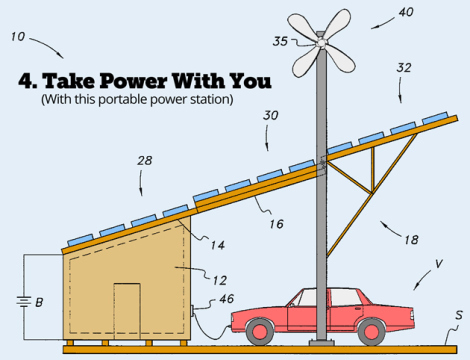
Portable energy on demand. (Grist)
CURWOOD: So let’s talk about a couple of them. What about the patent for a better de-icer for car windows? How would that work?
WEST: Well, lok anybody that has been in cold climate knows how annoying it is when you’re tired, caffeine is barely rushing through your blood, and you have to de-ice, de-fog your car in the morning. So this guy called Jerry Lansinger, he now lives in Washington state, this guy has come up with a way to de-ice a windshield in less than a minute.
CURWOOD: How would this work?
WEST: This is a specially designed heat exchanger installed in the engine which rapidly converts the existant heat in the engine into hot water, and then it’s sprayed out into nozzles onto the windshield itself. And the inventor, Jerry Lansinger, said he’s recorded times of 45 seconds for a complete de-icing of your windshield. So that’s a lot less than the average 15 to 20 minutes in all, and it will get you on the road a lot earlier in the mornings, and also be better for the environment.
CURWOOD: Now there’s another patent that you looked at which is fake sea ice. How would this work?
WEST: Well, this one was really interesting. This guy called Phillip Langhorst from St. Louis has invented this ice substrate that he envisions someday to be dropped on the surface of oceans or lakes to reflect sunlight back into space, so this is a kind of geo-hacking or geo-engineering measure, and these things are going to be giant sheets of what he calls “artificial ice”. Now underneath though he also plans to sow nutrients so that sea life that grow on the bottom of these things that may then be able to be harvested for biofuels.
CURWOOD: What concerns were expressed in the patent about the possible side effects of covering the surface of the ocean with this fake ice?
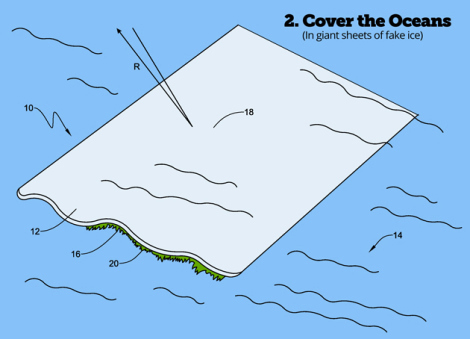
Fake sea ice and biofuel growing platform. (Grist)
WEST: Phillip was like, well look, we’re talking about the deep future here where everything else has failed; we’ve failed to come to any international agreement on this and we need to do something drastic. He basically said, “Pick your poison. Either we get very warm and we can’t deal with it, or we have to invest in something like this.” So he was saying the possible side effects are you know putting this stuff onto a very lively ocean and killing stuff that’s already there, and the cost, obviously, of developing this stuff at such a scale that we overlay the oceans in the western Pacific with fake ice structures is obviously going to be prohibitive, and of course, the companies that he’s approached have already bought to this idea and said, “Um, not sure, Phillip, whether this is going to be a viable commercial option.”
CURWOOD: Now, there’s another idea that kind of looks cool. This is a collapsable, portable source of renewable energy. There’s a diagram with the article that shows the car hooked up directly to a windmill. What’s the idea here?
WEST: Yes. So this is the idea that if, and I’m particularly thinking in kind of emergency situations, post-Sandy, here in New York there was a desperate need to get portable power into places where the grid had failed. There’s an inventor in Crossville, Tenn. called Lynn Miller who’s come up with this idea of a portable power station. This is something you can put on the back of a trailer and literally unfold onto a flat surface, by the side of the road, or in a parking lot, and the idea is there’s a roof with an array of solar panels and this wind turbine that can be thrown up into the sky at a moment’s notice and it’s plug and play. This thing essentially unloads and generates power immediately.
CURWOOD: So, James, you actually talked to the people that wrote these patents, right?
WEST: I did. It was actually great connecting with these inventors because they’re so passionate about the things that they have invented, sometimes for many, many years. You know, Jerry Langsinger in Washington state, he’d been tinkering for 20 years in his garage to produce this new windshield, rapid defrosting system, and so you really get a sense of people’s passion about this which was really exciting.
CURWOOD: I understand though that there was one more patent writer that you couldn’t get through to - that’s Nike. Tell me about their new idea?
WEST: OK. Yes. So this is the one inventor that I wasn’t allowed to get through to. This is the carbon-sucking golf ball that the golf team at Nike has actually invented and patented through the US Patent Office.
CURWOOD: Wait a second. Carbon-sucking golf ball?
WEST: Carbon-sucking golf balls! This is an actual patented invention by Nike if you can believe. it. You can’t make this stuff up.
CURWOOD: Well, how exactly would this thing work?
WEST: You know, I have to say, I was pretty impressed by the science of this. It’s a pretty technical whizbang type of thing. The outside of the golf ball deforms somewhat, this layer, and that sets up this chain reaction so that as it’s whizzing through the air, it’s sequestering carbon out of the atmosphere. At the end of 18 holes, you’re able to look at this ball, and see how much, through a some kind of visual indicator on the side of the ball, how much carbon you’ve been able to suck out of the atmosphere along the golf course, and the more swings, the more carbon that you’re going to suck of the atmosphere - so that would make me a major climate action hero at that point. But the patent does say that these golf balls at best will only ever deal with the amount of the carbon that’s required to produce them. I wouldn’t really bank on this replacing any kind of agreement being hammered out right now in Warsaw, for example, or future UN Climate agreements.
CURWOOD: James West is a Senior Producer for ClimateDesk. Thanks so much, James.
WEST: Any time.
Related link:
James West in Grist
[MUSIC: James Booker “All These Things” from Classified (Remixed and Expanded) (Rounder Records 2013)]
CURWOOD: Coming up...an active volcano is discovered hidden under a mile of ice. That’s just ahead on Living on Earth. Stay tuned.
ANNOUNCER: Funding for Living on Earth comes from the Grantham Foundation for the protection of the environment. Supporting strategic communications and collaboration in solving the world’s most pressing environmental problems. The Gordon and Betty Moore Foundation. The Kendeda Fund, furthering the values that contribute to a healthy planet, and Gilman Ordway for coverage of conservation and environmental change. This is PRI, Public Radio International.
[CUTAWAY MUSIC: Dr. John: “Mississippi Mud” from Dr. John Plays Mac Rebennack – The Legendary Sessions Vol 2 (Clean Cuts Records 2006) Happy Birthday Dr. John (11/21/1940)]
Antarctic Volcano

Mt. Sidley is the largest known volcano in Antarctica. Unlike the active one found under the West Antarctic ice sheet, Mt. Sidley hasn’t erupted in millions of years. (photo: Doug Wiens)
CURWOOD: It's Living on Earth, I'm Steve Curwood. For years scientists have been concerned that a warmer Earth might lead to the melting and sudden collapse of the West Antarctic ice sheet, which could add as much as ten feet to world sea levels. Now scientists at Washington University in St. Louis have discovered a surprising new threat lurking beneath the West Antarctic ice sheet - an active volcano. Joining us to discuss the finding is Douglas Wiens, professor of Earth and Planetary Sciences at Washington University. Welcome to Living on Earth.
WIENS: Thank you. I’m glad to be here.
CURWOOD: So, imagine that! A volcano beneath Antarctica, huh?
WIENS: Well, we’ve known there’s volcanoes around Antarctica, but what’s kind of unique about this one is it’s below about a mile of ice.
CURWOOD: Where is it exactly?

Installing seismographs in the ice (photo: Doug Wiens)
WIENS: There’s a remote corner of West Antarctica called Marie Byrd Land. It’s maybe about 400 miles from the coastline.
CURWOOD: So where it is in West Antarctica, this is under the West Antarctica ice sheet?
WIENS: Yes.
CURWOOD: So when’s the last time you think this volcano blew?
WIENS: We have no way of knowing. So in 2010, we went out and put seismographs in this area, and as soon as we put the seismographs down they were recording these small earthquakes that are related to the movement of magma beneath the ice sheet. So we don’t really know when the activity started, we think this activity does not mean there’s an eruption going on now, but there could have been an eruption almost any time in the past and we wouldn’t know.
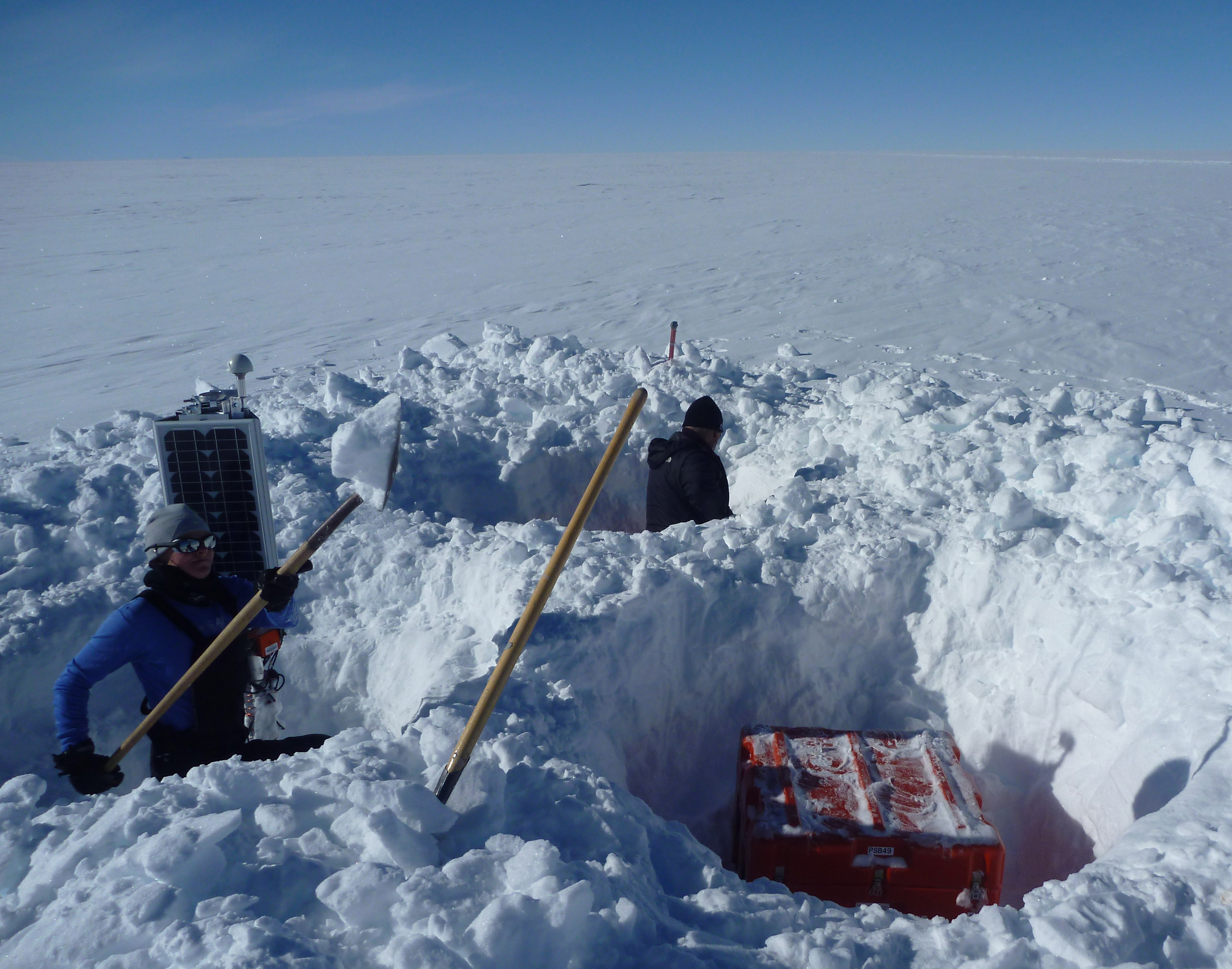
Installing the equipment (photo: Doug Wiens)
CURWOOD: So how many volcanoes are down there do you think?
WIENS: Well, that’s a really good question. I think there’s quite a number of undiscovered volcanos across west Antarctica. There’s a few of the big ones that stick out, so like this newly discovered volcano is about 30 or 40 miles from Mount Sidley, which is this spectacular volcano that sticks out of the ice sheet and was first discovered by Robert Byrd when he flew across Antarctica in the 1930s. But that volcano hasn’t erupted for three million years so we had no idea whether volcanoes in this area were currently active.
CURWOOD: So what are the chances the thing underneath the ice erupts?
WIENS: Well, we would think it would be pretty good. If you have this kind of volcanic earthquakes, they’re only found beneath active volcanos such as in Cascadia, in Pacific Northwest, or Alaska or Japan or Hawaii. Those are places where active volcanos have had this kind of earthquakes beneath it. So we think that there’s a pretty good chance that at some point in the future this volcano will erupt.

Amanda Lough, the lead author on the paper in Nature Geosciences (photo: Doug Wiens)
CURWOOD: And the question is, of course, how soon?
WIENS: How soon and how large of an eruption? And we really don’t know much about what happens when a volcano erupts under this much ice. I mean there’s a lot of study of volcanoes in Iceland, for example, that erupt beneath a few hundred feet of ice, but beneath a mile of ice is something we haven’t really considered very much.
CURWOOD: What happens in Iceland?
WIENS: Well, in Iceland, they have something called a jokulhlaup - I don’t know if I’ve pronounced it exactly right, - but basically a lot of water builds up underneath the ice as the volcano heats up, and then it all of sudden rushes out towards the ocean in kind of a catastrophic flood. Something somewhat similar may happen in Antarctica, but here the ocean is about 500 miles away, so the water has to go a long way.
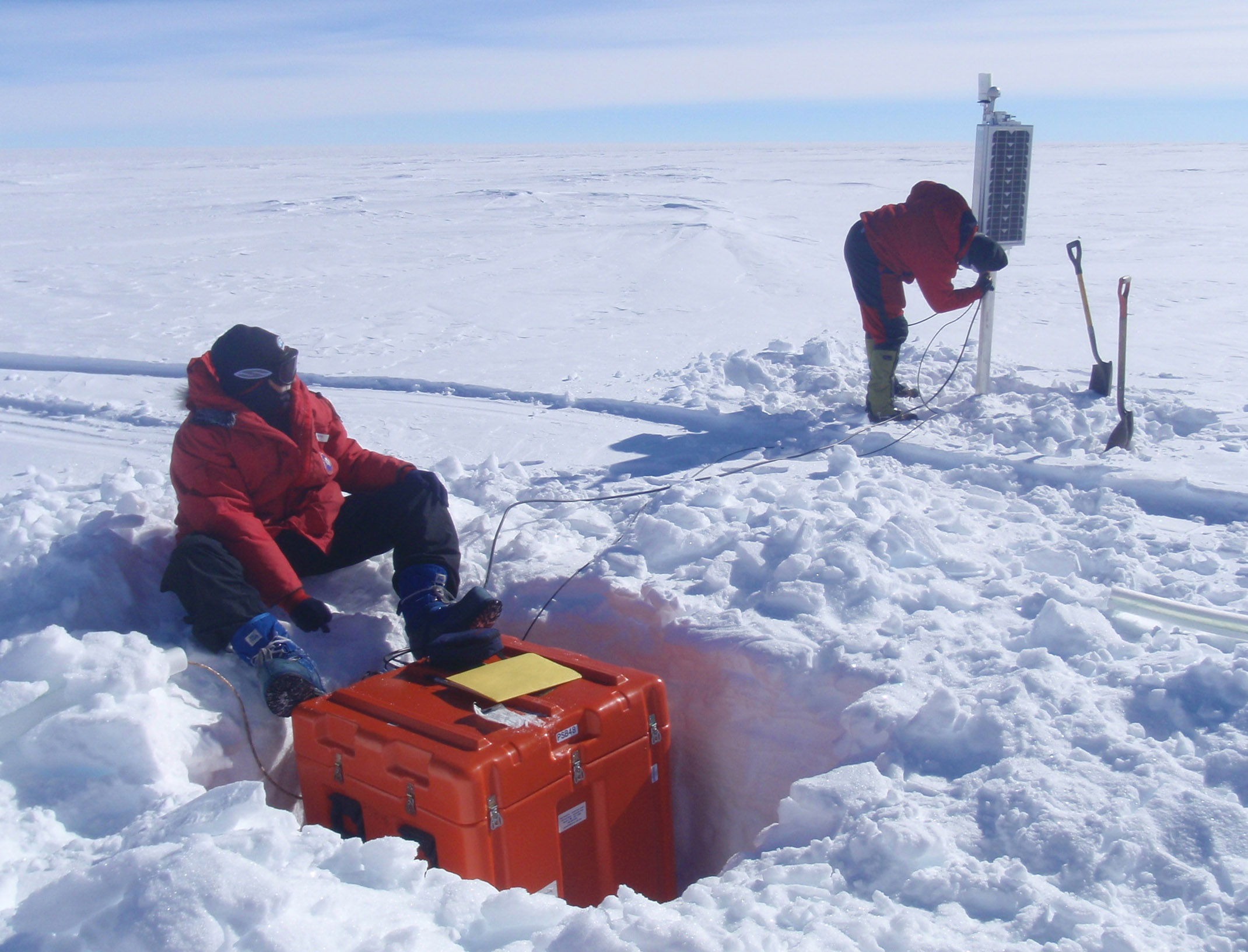
Scientists burying seismographs in the icepack of Antarctica (photo: Doug Wiens)
CURWOOD: What are the odds an eruption could melt through the ice sheet?
WIENS: Well, we did a little calculation for our paper for Amanda Lough, that’s my graduate student for her paper in Nature Geosciences, and her calculation suggested that if we had a really really large eruption, like some of the most famous large eruptions in history like Krakatoa or Mount Tambora, that such an eruption would melt through the ice sheet and vent to the atmosphere, but that a small sort of garden variety eruption would not and would essentially build up a large amount of melted water beneath the ice.
CURWOOD: West Antarctic ice sheet is kind of like a boat run aground. What are the odds that this volcano could help push portions that ice sheet into the ocean?
WIENS: Well, we don’t think this volcano would catastrophically melt the West Antarctic ice sheet. I think that’s probably out of the picture. An eruption like this though could perturb the ice sheet and maybe for a period of years cause increased flow of the ice sheet towards the oceans, and so that would maybe increase the rate of melting for a while. I wouldn’t encourage any sort of doomsday scenarios though with the volcano. There is a larger question in West Antarctica which is what is the amount of heat coming into the bottom of the ice sheet from the Earth, and how does that affect the ice sheet and its behavior?
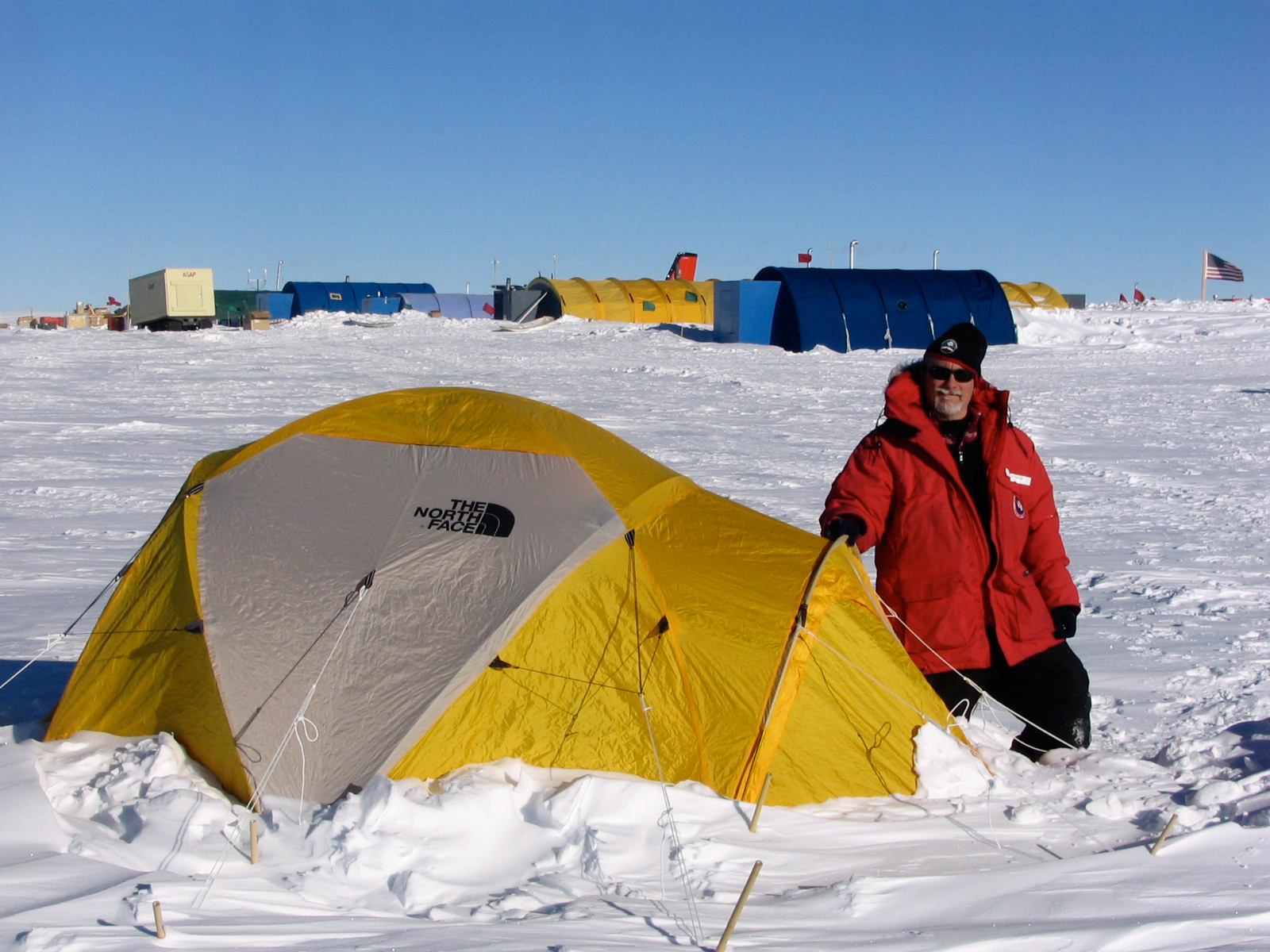
Doug Wiens outside his tent in Anarctica (photo: Doug Wiens)
CURWOOD: OK. So you asked the question and what do you think the answers might be?
WIENS: Well, there is some evidence recently that the heat flow into the bottom of the ice sheet is larger than what we thought. So there was an ice core in the West Antarctic ice sheet ice drilling project at a place called Wais in west Antarctica, and it has found a higher level of heat flow that anybody thought. So there are indications like this volcano, like this high heat flow measurement, that the heat flow is higher in West Antarctica than we previously thought.
CURWOOD: And that means the water would be going back to the ocean which of course would raise sea level if that ultimately happens?

Doug Wiens looking a little icy (photo: Doug Wiens)
WIENS: Yes, because if the ice moves faster from the middle of Antarctica to the edges, it doesn’t melt in the middle. We’re there on the hottest day of the year and it’s way below freezing. The ice only melts at the edges though, and so the faster that the ice moves from the center to the edges, the faster that the ice is going to melt, and so that’s what we’re really worried about. How fast is that ice moving from the center to the edge and how is that going to change in the future?
CURWOOD: Douglas Wiens is a Professor of Earth and Planetary Sciences at Washington University in St Louis. Thanks for taking the time today.
WIENS: Yes, thanks for having me on your show.
Related link:
Check out Prof. Doug Wiens’ webpage
[MUSIC: Allen Toussaint “Holy Cow” from Songbook (Rounder Records 2013)]
BEYOND THE HEADLINES

A stamp commemorating the flight of the Concorde (photo: bigstockphoto.com)
CURWOOD: And now, we turn to some stories from beyond the headlines with Peter Dykstra, who publishes the Daily Climate and Environmental Health News. He and his team find eclectic stories of environmental change from all round the planet in their daily search of the web, everything from the unusual to little-noticed topics that bear watching as they emerge over time. Peter Dykstra's on the line now from Conyers, Georgia. Hi there Peter!
DYKSTRA: Hi Steve!
CURWOOD: So this week you’ve got some things for us including a story about a journalist and a general?
DYKSTRA: That’s right. We picked up a piece from the New Orleans Times-Picayune. John Barry’s a famous accomplished historian and author. He wrote a great book about the Mississippi River floods back in 1927, kind of a pre-Katrina for Louisiana. He’s teamed up with General Russel Honoré. He was the guy they called the “John Wayne Dude”, he was the hero of Katrina, the guy that came in and restored order in New Orleans, remember him?
CURWOOD: Oh, yes. How could you forget him?
DYKSTRA: Well, the General is putting together what he calls a “Green Army” for Louisiana. They’re looking to set up some legislative goals to help save Louisiana coastline. There have been huge problems along the coast with erosion. The oil and gas industry and all the pipelines and channels and canals that are the culprits, and General Honoré and John Barry the author are among many people who feel that the state government in Louisiana is a little too cozy with the oil and gas industry, and they’re going to focus on that in coming years.
CURWOOD: So we might get to see how mighty the pen and the sword are when they’re together, huh?
DYKSTRA: I’m looking forward to seeing how that works out.
CURWOOD: Hey, Peter, what about this toxic mystery that might be good news?
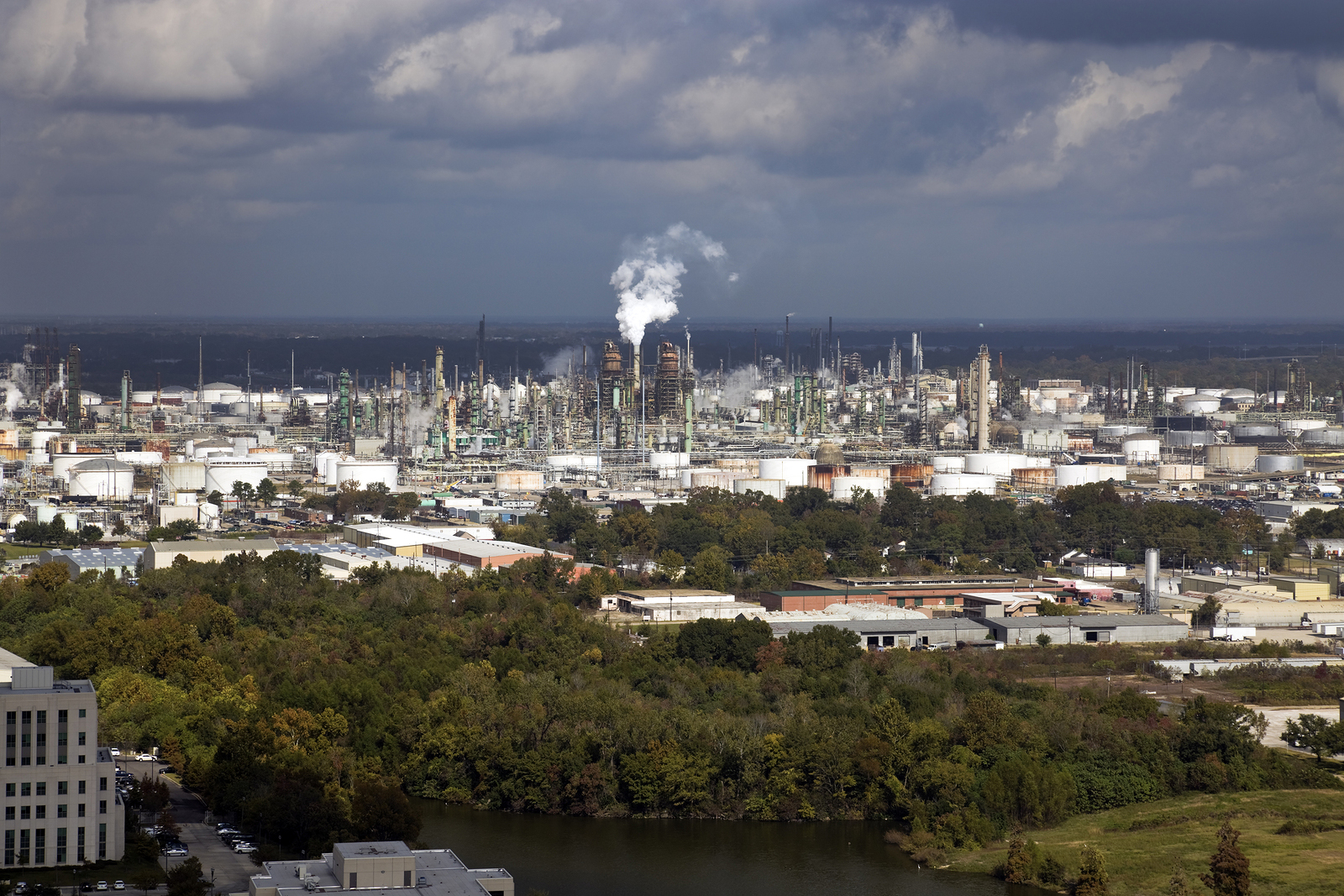
The industrial refineries in Baton Rouge (photo: bigstockphoto.com)
DYKSTRA: It might be good news. It might just be a mystery. It’s going to take some time to figure it out, but we at EHN picked up the story from the Daily Breeze, a newspaper in Torrance, Calif. Out there in Torrance, which is south of LA, there was a chemical factory, the Montrose Chemical Company, they manufactured the DDT pesticide until it was outlawed. They also had a huge offshore toxic waste dump, and there are about 1,000 tons believed to be out in the Pacific south of LA, DDT and PCB’s - another carcinogen that was also outlawed. They stay highly toxic for decades, they’re constantly monitored for contamination. Scientists were finding really high contamination levels until about four years ago, and then in the last four years they’ve dropped dramatically.
CURWOOD: And the reason for this?
DYKSTRA: No idea, yet. There are a lot of possibilities. There’s chemicals which are very persistent. They stay in the environment for a long time, may be breaking down faster than we thought. They might have been pushed somewhere along the sea bed. They might be buried in sediment. It might be a good news story, but for now, it’s just a mystery.
CURWOOD: Hey, maybe it’s some saltwater loving microbes that like to eat DDT and PCBs, huh?
DYKSTRA: Could be. I think the scientists have that one on the list, but it may take a few more years to sort it out and have an answer.
CURWOOD: Hey, Peter, before you go, give us another look back in history, would you please?
DYKSTRA: Ten years ago this month, we saw the last Flight of the Concorde – the supersonic airliner, the SST. It could take you from London to New York in three-and-a-half hours. It launched in the ’70s, and the Concorde was a miracle, but it also had a lot of environmental baggage it was carrying.
CURWOOD: What were the issues back then?
DYKSTRA: Well, for starters, it was extremely loud, and that upset a lot of people who live near JFK airport in New York and Heathrow in London. It also burned a huge amount of fuel. It was alleged at the time that the Concord would destroy the ozone layer, that it would cause massive bird kills from the sonic boom, and those last two things never happened. We also found better ways to destroy the ozone layer. It also attracted celebrity opponents and supporters. Sir Alec Guinness opposed the Concorde landing in Heathrow, and on this side of the ocean one of the big supporters was Henry Kissinger.
CURWOOD: The Secretary of State versus the Jedi Master, huh?
DYKSTRA: Yes, that would have been one light-saber fight to watch. The Concorde finally got OK to fly into the US in 1977, which of course is also the year, the first Star Wars movie came out. It was operated not by a US airline but by British Airways and Air France. By all measures it was profitable until the year 2000 and then disaster hit. There was a fiery crash of the Concorde in Paris - no survivors. They grounded the plane for a year to try and figure out safety issues. It got up in the air briefly, but by the year 2003, the airlines gave up on it due to rising fuel costs and declining interests, and of course, since then, we’ve learned a lot more about what a big contributor that even standard conventional airliners are to greenhouse gas emissions.
CURWOOD: Gee, I never got to fly on the SST, and I guess it’s unlikely that I ever will, huh?
DYKSTRA: Now they’re in museums, but they’re not making them anymore, they’re not out there, and even then, 10 and 20 years ago, the fare for the SST was above our paygrade.
CURWOOD: Oh, yes. That doesn’t work in public radio does it? Peter Dykstra is publisher of Daily Climate and Environmental Health News. Thanks, Peter.
DYKSTRA: Thanks, Steve.
Related link:
Peter Dykstra’s website, the Daily Climate
[MUSIC: Champion Jack Dupree “President Kennedy Blues” from The Blues Of Champion Jack Dupree (Storyville Records 2000)]
Vegans Say It's Even Better Than Turkey
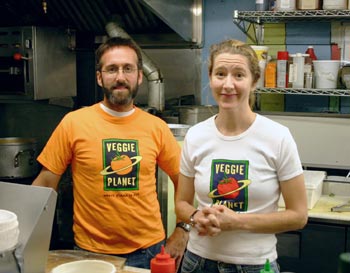
Veggie Planet co-owners Didi Emmons and Adam Penn in their restaurant kitchen (Photo: Brandon Nastanski)
CURWOOD: Traditionally turkey takes center stage at Thanksgiving dinner. But many people who eat no meat can find themselves just left with the sides. Unless they know someone like Didi Emmons. She's a well-known chef in Massachusetts, and author of numerous cookbooks including “Vegetarian Planet.”
[CHOPPING SOUNDS]
Each year, she hosts a Thanksgiving spread for vegans who steer clear not only of meat but also eggs and dairy. A few years ago Emmons invited us into her kitchen while she prepared the dish that will replace tom turkey on her Thanksgiving table.
EMMONS: When people know they’re going to a vegan Thanksgiving dinner, you know, they know they’re not going to be getting that big bird. But I think that what they do want is something that is similar, that has the same kind of chew value. Turkey, you know, like any meat, it’s much harder to chew than a vegetable, and there’s something really kind of very satisfying, probably it goes back to our hunting days.
[SOUND OF POT LIDS, COOKWARE HANDLED]
EMMONS: For this year’s vegan Thanksgiving we’re going to have a roasted seitan, which is going to be, you know, the bird. Seitan is wheat gluten, and more than tofu, and more than tempeh, really has great chew. And it also has good flavor. It’s got much better flavor than tofu.
[CRINKLING SOUNDS]
EMMONS: It comes in this box. And I’m throwing the wheat gluten into a bowl. And it’s pretty simple, even a six-year-old could do it. You’re just adding water...
[RUNNING WATER]
EMMONS: – and all of a sudden, it starts to look a little brainy. It starts to kind of…it’s just strange. It doesn’t look like your regular average dough.
[WET KNEADING SOUNDS]
EMMONS: So right now, as the seitan is resting, I’m making its braising liquid. It’s gonna have to braise in a liquid. It’s gonna have to cook for an hour.
[RUNNING WATER]
EMMONS: Turkey already has a lot of flavor, but seitan needs a little help. I’ve added an onion, I’ve added a bunch of garlic, I’ve added fresh tarragon, a lot of Worcestershire sauce. I’m gonna add about a quart of water and a good amount of salt and pepper.
[RUNNING WATER, MIXING SOUNDS]
EMMONS: I’ll throw in a little more tarragon. Because it’s a special occasion – only comes around once a year.
[LIQUID, MACHINE SOUNDS]
EMMONS: We’re going to make a Portabello Madeira gravy. And what I’ve done is I’ve taken Portabello mushrooms and I’ve thrown them into a food processor and I’ve just kind of obliterated them. They’re just very finely ground. We’ve got the braising liquid from the seitan and that is a stock. And it’s a delicious stock, with the tarragon and the fennel seeds, and so we’re going to borrow some of that and we’re going to make gravy out of that.
[CLANG OF COOKING BOWLS]
EMMONS: It’s time for the seitan to hopefully be done. And the Worcestershire has given it a really lovely golden brown color. So we’re just going to put the seitan down like we would - the way that dad would put the turkey breast down on somebody’s plate. And then we’ve got our gravy, and we’re going to drizzle it right over the seitan. Mmm… [TASTING], it’s there. It’s everything I wanted it to be.
CURWOOD: Eco-chef Didi Emmons. Steve Gregory produced our audio postcard. To gobble up a recipe of her roasted seitan and other vegan Thanksgiving delights, head over to our website at LOE dot org.
EMMONS: Going vegan forces you to get into creativity, and that for me is something that’s a lot more fun than just eating what I’ve been eating every single year.
(This segment was originally broadcast in 2004.)
[WIND BLOWING, CROWS SQUAWKING]
CURWOOD: We leave you this week with a murder...
[CROWS SQUAWKING]
CURWOOD: A murder of crows, that is. The collective noun for these corvids dates back centuries. These noisy birds are complaining in a woodland on a blustery winter evening.
[CROWS SQUAWKING]
CURWOOD: Five carrion crows head to roost at dusk in Woodchester Park in Gloucestershire, England. Richard Margoschis recorded this murder for the British Library National Sound Archive CD, Wild Britain.
Related link:
Sample some of Didi Emmons' Vegan Thanksgiving Recipes
[MORE CROW SQUAWKS]
CURWOOD: Living on Earth is produced by the World Media Foundation. Naomi Arenberg, Bobby Bascomb, Emmett Fitzgerald, Helen Palmer, Kathryn Rodway, Adelaide Chen, James Curwood, Jennifer Marquis and Gabriela Romanow all help to make our show. Jeff Turton is our technical director. Alison Lirish Dean composed our themes. You can find us anytime at LOE.org, and like us on our Facebook page - it’s PRI’s Living on Earth. And we tweet from @LivingOnEarth. I'm Steve Curwood. Thanks for listening.
ANNOUNCER 1: Funding for Living on Earth comes from the Grantham Foundation for the protection of the environment. Supporting strategic communications and collaboration in solving the world’s most pressing environmental problems. The Kendeda Fund, furthering the values that contribute to a healthy planet, and Gilman Ordway for coverage of conservation and environmental change. Living on Earth is also supported by a friend of Red Tomato, supplier of righteous fruits and vegetables from northeast family farms. www.redtomato.org. This is PRI, Public Radio International.
ANNOUNCER 2: PRI, Public Radio International.
Living on Earth wants to hear from you!
Living on Earth
62 Calef Highway, Suite 212
Lee, NH 03861
Telephone: 617-287-4121
E-mail: comments@loe.org
Newsletter [Click here]
Donate to Living on Earth!
Living on Earth is an independent media program and relies entirely on contributions from listeners and institutions supporting public service. Please donate now to preserve an independent environmental voice.
NewsletterLiving on Earth offers a weekly delivery of the show's rundown to your mailbox. Sign up for our newsletter today!
 Sailors For The Sea: Be the change you want to sea.
Sailors For The Sea: Be the change you want to sea.
 The Grantham Foundation for the Protection of the Environment: Committed to protecting and improving the health of the global environment.
The Grantham Foundation for the Protection of the Environment: Committed to protecting and improving the health of the global environment.
 Contribute to Living on Earth and receive, as our gift to you, an archival print of one of Mark Seth Lender's extraordinary wildlife photographs. Follow the link to see Mark's current collection of photographs.
Contribute to Living on Earth and receive, as our gift to you, an archival print of one of Mark Seth Lender's extraordinary wildlife photographs. Follow the link to see Mark's current collection of photographs.
 Buy a signed copy of Mark Seth Lender's book Smeagull the Seagull & support Living on Earth
Buy a signed copy of Mark Seth Lender's book Smeagull the Seagull & support Living on Earth

